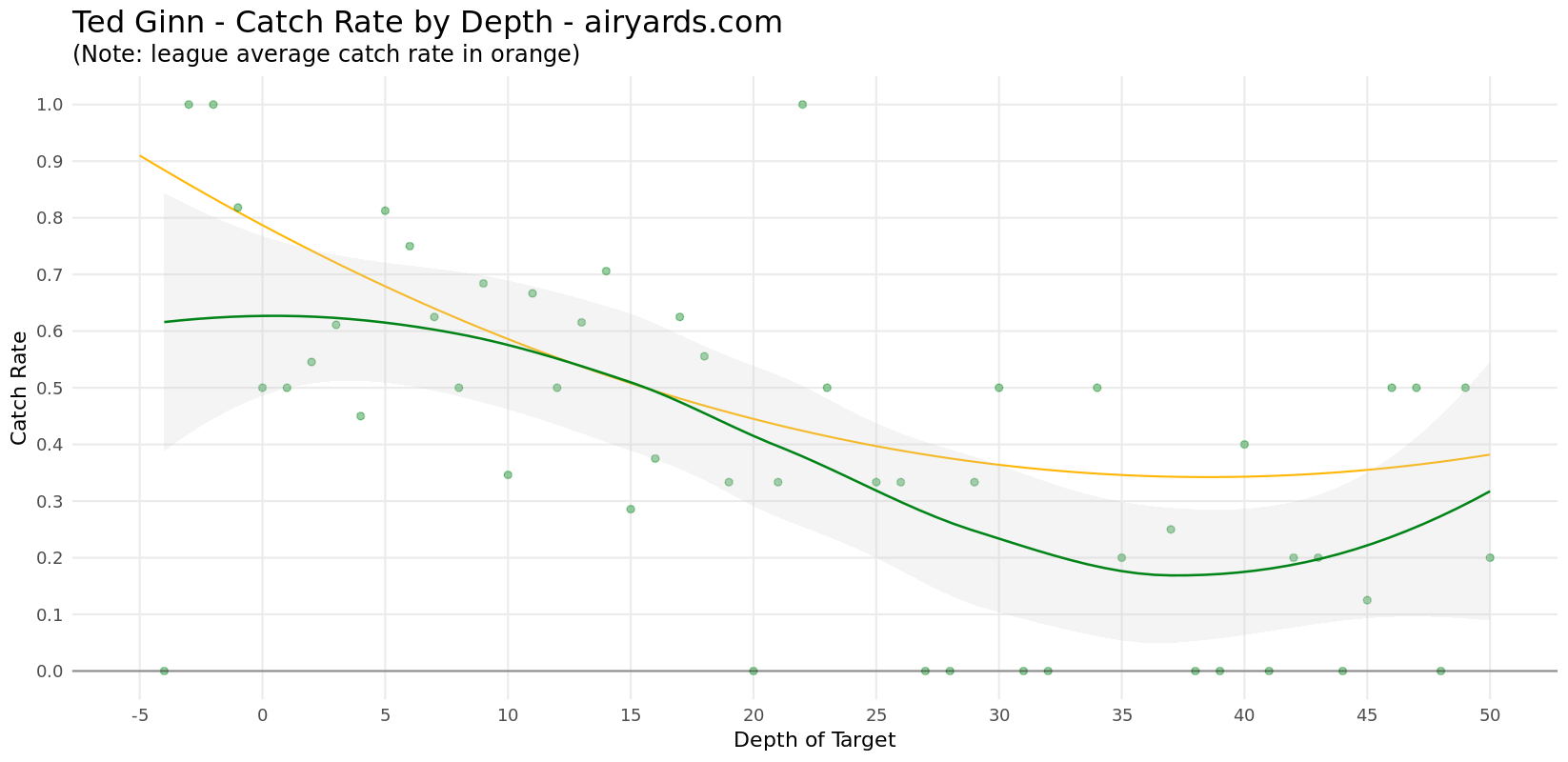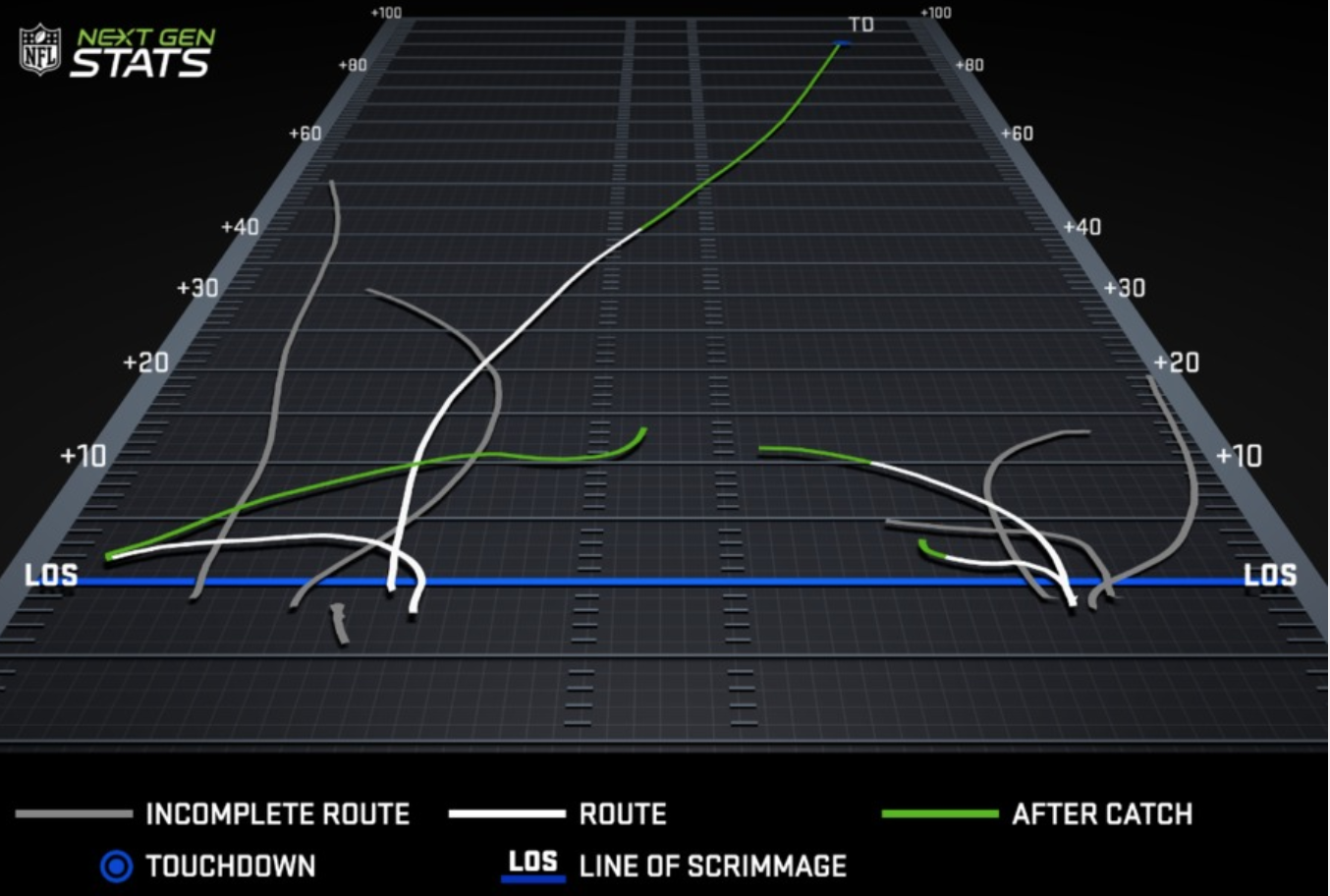Ted Ginn Has Become a Different Type of Big-Play Threat in New Orleans

In years past, Ted Ginn Jr. ran in a straight line down the field, and the quarterback hoped. Rarely was there a question if Ginn would get open down the field, but rather if he’d catch the ball once he did so. During his career, that’s been about a 50-50 proposition.
From 2009 to 2016, Ginn had a career catch rate of 51.7 percent. In 2016, the league average catch rate was around 60 percent. Throughout his career, Ginn has put up a below average catch rate at just about every part of the field. The deeper he went, the worse it got. Typically, that’s the case for all passes as they go farther down the field, but it’s an even bigger extreme for Ginn.
The below chart from airyards.com plots Ginn’s catch rate against the depth on the field of the target (green line) from 2009 -- as far as this data goes back -- to 2016. It’s also shown against the league average at each depth (orange line).

None of that is great. From 30 to 45 yards down the field, throwing to Ginn was slightly more reliable than an actual Hail Mary. Not ideal for a deep threat.
Now, if Ginn kept on that pace, there would be little reason for an article. So you can probably guess something has changed. Here’s the same chart just looking at Ginn’s 2017 so far.

This year, his first with the New Orleans Saints, Ginn has a catch rate over 80 percent -- 81.5 percent to be exact. That’s the best among 81 wide receivers with at least 25 targets in 2017. Danny Amendola of the New England Patriots is the only other receiver over 80 percent, and those two are also the only receivers over 77 percent. Only 11 receivers even have a catch rate over 70 percent.
That shift has made Ginn one of the most efficient receivers by Net Expected Points (NEP), our in-house metric. Ginn leads the aforementioned group of 81 receivers in Reception NEP per target this season at 1.16. He’s one of three wide receivers targeted at least 25 times to be worth over a full point per target, along with Nelson Agholor and Stefon Diggs.
Ginn has also gotten here without the benefit of long touchdowns. That’s probably what you think of when you picture a Ginn play, but he’s had just two receiving touchdowns so far this year. Meanwhile, Agholor has five touchdowns this season and Diggs has four in five games.
A Different Way
It was expected Ginn would be the deep threat for the New Orleans offense when he signed for the season, but that hasn’t really been the case.
Of New Orleans’s four main wide receivers, Ginn (9.7) has the lowest average depth of target (aDOT) behind Brandon Coleman (11.9), Tommylee Lewis (11.6), and Michael Thomas (10.0). This is the lowest aDOT of Ginn’s career, but it’s also coming in a way that has New Orleans putting him in a position to use his skills all over the field. Clearly, it’s paying off better than it has for Ginn in the past, when most of his work was down the field.
| Year | Team | aDOT | RecNEP/Target |
|---|---|---|---|
| 2009 | MIA | 15.7 | 0.54 |
| 2010 | SF | 14.6 | 0.31 |
| 2011 | SF | 10.9 | 0.57 |
| 2013 | CAR | 15.1 | 0.79 |
| 2014 | ARI | 14.8 | 0.52 |
| 2015 | CAR | 16.2 | 0.80 |
| 2016 | CAR | 12.3 | 0.63 |
| 2017 | NO | 9.7 | 1.16 |
New Orleans isn’t exclusively making Ginn run deep, but they’re still putting him in position to use the speed he has to get down the field, just now with the ball in his hands. We can take a look at somewhat close games over the past two seasons using some route charts from the NFL’s Next Gen Stats. This first game is from Week 12 in 2016 with the Carolina Panthers against the Oakland Raiders. Ginn had 10 targets, 4 receptions, 115 yards, and a touchdown. It was worth 1.03 Reception NEP per target.

Of the 10 targets, 5 were more than 10 yards down the field and just 1 was caught.
Now, let’s look at Ginn’s game from this past week against the Green Bay Packers. He caught all 7 targets for 141 yards but no touchdowns. Still, Ginn’s play was worth 1.51 Reception NEP per target. Only one target came more than 10 yards down the field, but four plays gained at least 15 yards.

One place Ginn and the Saints have really clicked is in the screen game. Last year, Ginn was one of 22 receivers who had at least 10 wide receiver screens. He was last among those wideouts with just 4.7 yards after catch, which is basically what screens are set up to do. In total, Ginn produced 31 yards on those 10 screens. Against the Packers alone last week, Ginn ran four screens for 45 yards.
The Saints are even using Ginn’s history and potential as a deep threat to open up more intermediate throws. Against the Packers, Ginn gained 47 yards on a curl after the cornerback kept running downfield after Ginn broke off his route. There wasn’t a defender within five yards of Ginn at the catch, and Ginn had plenty of room to turn up the field for a big gain.
Per the NFL’s Next Gen Stats, Ginn has the the third-highest average separation from defenders on his targeted passes at 3.7 yards. Last year, he had an average separation of three yards, which tied for 28th. Passing windows are not wide in the NFL, so an average increase of 0.7 yards of separation is a pretty big deal, especially with the speed Ginn still possesses.
These shorter throws have also provided easier balls to catch for Ginn, who has typically found himself near the top of the drops list each season. Per Sports Info Solutions charting from Football Outsiders, he had seven drops in 2015 and six in 2016. Those are drop rates of 7.2 percent and 6.3 percent, respectively. This year, he’s been charted with just 1 drop on his 27 targets, a more manageable 3.7 percent rate.
Right now Ginn is fourth on the Saints in targets, though second for wide receivers. He’s done all this without Willie Snead, who has played 21 snaps this season due to suspension and injury. Ginn has also played just 59.1 percent of the Saints’ offensive snaps this season, which is third at receiver behind Thomas and Coleman.
Still, Ginn is getting the opportunities when he’s on the field, which is a good sign for the future. Even if the volume goes down, the way Ginn has been set up to succeed in the offense can make whatever targets he does get meaningful. Ginn is still very much a big-play threat, though this year those big plays might look a little different.
















